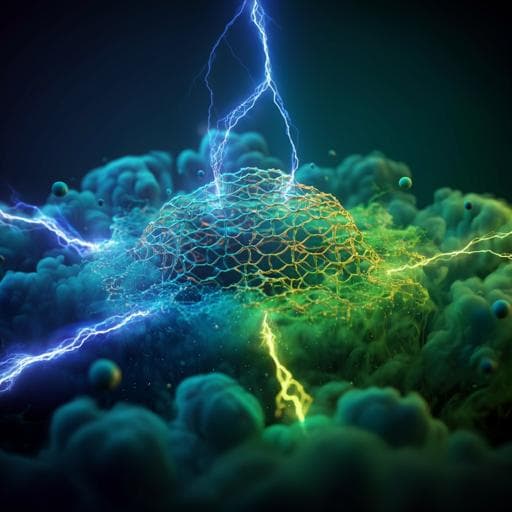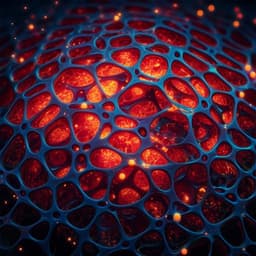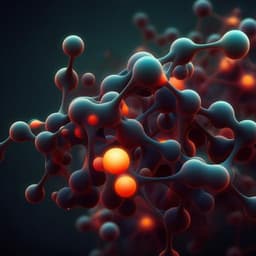
Chemistry
High-rate and selective conversion of CO₂ from aqueous solutions to hydrocarbons
C. A. Obasanjo, G. Gao, et al.
Unlock the potential of renewable energy with groundbreaking research by Cornelius A. Obasanjo, Guorui Gao, Jackson Crane, Viktoria Golovanova, F. Pelayo García de Arquer, and Cao-Thang Dinh. This study introduces an innovative electrochemical system for converting carbon dioxide into methane with over 70% efficiency, offering a sustainable solution for electricity storage and emissions reduction.
~3 min • Beginner • English
Introduction
The study targets high-rate, energy-efficient electrochemical reduction of CO2 (ECR) to methane (CH4), a desirable fuel for integrating renewable electricity into existing natural gas infrastructure due to CH4’s high energy density and market penetration. Practical ECR requires high current densities (>300 mA cm−2), high selectivity, minimized CO2 losses, and high product concentrations to reduce separation costs. While gas-phase systems (flow cells and MEAs) can reach high CH4 selectivity at substantial current densities, they often suffer from carbonate formation or CO2 crossover and diluted product streams. Bicarbonate-fed systems coupled with bipolar membranes (BPMs) integrate CO2 capture and conversion by generating CO2 in situ via proton reaction with (bi)carbonate, improving carbon utilization and product concentration. However, prior bicarbonate-fed systems exhibit relatively low CH4 selectivity (state-of-the-art FE ~30% at 120 mA cm−2), likely due to suboptimal local reaction environments (CO2 availability and pH) and lack of selective, stable catalysts under high current conditions. This work investigates controlling mass transport and dynamic catalyst surface states to enable high CH4 selectivity at high rates in aqueous-fed BPM systems.
Literature Review
Previous gas-phase ECR platforms demonstrated CO2-to-CH4 Faradaic efficiencies (FEs) of 60–70% at 200–300 mA cm−2 but often require alkaline conditions or AEMs, leading to carbonate formation or CO2 crossover and additional separation energy. Bicarbonate-fed BPM systems have shown high selectivity for CO and formate at 70–150 mA cm−2 partial currents, integrating capture and conversion with improved carbon utilization and product concentration. For CH4 in bicarbonate-fed setups, reported performance was limited (FE ~30%, partial current ~120 mA cm−2). Factors influencing hydrocarbon selectivity on Cu at lower current densities include active site nature, surface roughness, and electrolyte/pH. Operando studies indicate Cu surfaces reconstruct under ECR, often favoring H2 at high currents. This work builds on these insights, hypothesizing that enhancing CO2 availability via an open matrix electrode and maintaining selective oxide-derived Cu surfaces via alternating oxidation-reduction could overcome prior limitations.
Methodology
The authors combined multiphysics modeling and experiments. Modeling: A 1D steady-state model of the catalyst layer and cation-exchange layer (CEL) considered species transport (HCO3−, K+, CO3 2−, OH−, H+, CO2) via Nernst–Planck with electroneutrality, Bruggeman-corrected diffusion, Butler–Volmer kinetics for H2 and CH4, CO2 phase transfer (Henry’s law), finite-rate buffer equilibria, and BPM proton flux boundary conditions. Porosity: open matrix 0.99 (specific area 10 m−1), dense matrix 0.8 (specific area 10^2 m−1); assumed Sherwood numbers: 36.6 (open) and 3.66 (dense). CO2 sparging set CO2 to saturation (33 mM); N2 sparging set equilibrium CO2 (~1.5 mM at 0.3 M KHCO3). Proton flux at BPM boundary matched current with transference number 0.75. The model tracked CO2 flux sources/sinks (flow-channel influx, in situ generation via H+ + HCO3−, consumption to CH4, and phase transfer via bubbling) and predicted local pH and CH4 FE under various conditions. Experimental system: Two-electrode MEA flow cell with Cu mesh cathode (open matrix, 100 ppi, ~150 µm pores, ~100 µm wire; direct membrane contact) and Ni foam anode (80–100 ppi, 1.5 mm thick) separated by a BPM (Fumasep); AEM used for controls. Catholyte: 0.1, 0.3, or 1.0 M KHCO3 (1 L reservoir); Anolyte: 1 M KOH (200 mL). Flow rate: 30 mL min−1. Catholyte purged continuously with CO2 (50 sccm) or N2. Potentiostat with 10 A booster controlled currents. Operating modes: (1) Constant reduction current; (2) Pre-activation by 10 CV cycles between −20 and +10 mA cm−2; (3) Alternating square-wave currents with oxidation (typically 2.5 mA cm−2 for 5 s, varied 0.1–5 mA cm−2 and 1–10 s) and reduction (100–750 mA cm−2, duration varied 5–50 s; often 25 s). Gas analysis via GC (TCD for CO, CO2, H2; FID for CH4, C2H4) with Ar carrier; dilution during oxidation accounted for in FE calculations by time-weighted correction. Liquid products quantified by 1H NMR. Surface characterization: SEM and XPS (Cu 2p). Double-layer capacitance in H-cell used to estimate roughness factors versus an ideally smooth Cu capacitance (0.029 mF cm−2). Controls: AEM operation to isolate dissolved CO2 source; BPM with N2-saturated KHCO3 to isolate in-situ CO2; varied KHCO3 concentrations; alternative IrOx/Ti anode; intentional Ni/Fe additions. Stability: 12 h tests at 250 and 500 mA cm−2. Product concentration: gas–liquid separator with electrolyte recycle to CO2 saturator; outlet gas composition measured across current densities.
Key Findings
- Modeling: Dense porous catalysts with N2 sparging suffer from low in-situ CO2 generation and negligible flow-channel CO2 influx at high current, yielding low CH4 FE. Open matrix design greatly increases diffusivity and boundary mass transfer, boosting in-situ CO2 generation; adding CO2 sparging further increases flow-channel CO2 influx, enabling modeled CH4 FEs up to ~65% at 500 mA cm−2. Optimal performance observed across 0.1–1 M KHCO3, with 0.3 M favorable. - Catalyst activation: Constant reduction on as-received Cu mesh gave H2 FE >90% and CH4 FE <0.5% at 250 mA cm−2. Pre-activation via 10 redox CV cycles increased initial CH4 FE to ~25% and reduced H2 FE to ~50%, but CH4 FE decayed to ~3% within 60 min under constant reduction. - Alternating current operation maintained selective surfaces: With oxidation 0.5 mA cm−2 for 3 s and reduction 250 mA cm−2 for 25 s, CH4 FE stabilized at 55–60% and H2 at ~30%. Optimizing oxidation current/time and reduction time improved selectivity: • Oxidation current density effect (fixed 5 s oxidation, 25 s reduction): At 2.5 mA cm−2, CH4 FE >70% at 250 and 500 mA cm−2; at 750 mA cm−2, CH4 FE 67.8% with CH4 partial current 508.5 mA cm−2. • Oxidation time effect (2.5 mA cm−2 oxidation): Longer oxidation times enhanced CH4 FE, especially at high current. • Reduction time effect (2.5 mA cm−2 oxidation, 5 s): Shorter reduction times increased CH4 FE; with 5 s reduction, CH4 FE >70% for 100–750 mA cm−2; peak CH4 FE 77% at 500 mA cm−2; CH4 partial current up to 525 mA cm−2 at total 750 mA cm−2. Tradeoff observed between high instantaneous FE and effective duty cycle; maximum effective CH4 partial current >400 mA cm−2 with 25 s reduction. - Cell voltage: 3.52 V (100 mA cm−2), 4.25 V (250), 5.4 V (500), 7.57 V (750). Energy efficiency: 15–18% at 250–500 mA cm−2. - Product concentration: Outlet CH4 concentration reached 23.5% at 500 mA cm−2; CH4:unreacted CO2 molar ratio 40.7%, exceeding prior reports (~34%). - Stability: CH4 FE ~70–75% (250 mA cm−2) and ~65–70% (500 mA cm−2) maintained for 12 h; minor rise in C2H4 from ~2% to ~4%. - Morphology and composition: Constant reduction led to irregular Cu nanoparticles; alternating operation induced porous Cu structures that intensified with higher oxidation frequency (shorter reduction times). XPS showed Cu0 and CuO features in all samples, likely from air exposure post-reaction. - Mechanistic insights: Both dissolved CO2 and in-situ generated CO2 are required for high CH4 selectivity at high currents. AEM experiments (dissolved CO2 only) delivered up to 52% CH4 FE at 100–250 mA cm−2 but <40% at 500–750 mA cm−2. BPM with N2-saturated KHCO3 (primarily in-situ CO2) gave max 27% CH4 FE at 500 mA cm−2 (partial 135 mA cm−2). Optimal KHCO3 concentration was 0.3 M at high currents; local pH estimated 10–12 (optimal ~10.5–11) for relatively flat Cu favored CH4. Higher surface roughness favored C2H4; thermally roughened Cu (roughness factor ~590) produced C2H4 (15–25% FE) and suppressed CH4 (<1%). Alternating operation is necessary to sustain high CH4 FE even on activated surfaces.
Discussion
The work addresses the central challenge of achieving high selectivity and productivity for CH4 in aqueous bicarbonate-fed electrolyzers. By engineering mass transport with an open-matrix Cu mesh, the system leverages both dissolved CO2 and in-situ generated CO2, overcoming CO2 limitations that plague dense electrodes. Periodic oxidation pulses regenerate selective Cu surface motifs, counteracting surface reconstruction that otherwise shifts selectivity toward H2 under steady high-current operation. The combined strategy yields CH4 FEs >70% across a broad current range, high effective partial currents (>400 mA cm−2), and elevated outlet CH4 concentrations (23.5%), with energy efficiencies comparable to the best MEA systems but with minimized CO2 crossover and higher product concentration. Mechanistically, performance hinges on maintaining optimal local pH (≈10.5–11) and relatively low surface roughness to favor CH4 over C2+ pathways, while dynamic operation sustains the active surface state. The findings demonstrate that bicarbonate-fed, aqueous-phase systems can match or surpass gas-phase platforms in CH4 selectivity and output while offering integration with CO2 capture and reduced downstream separations.
Conclusion
This study demonstrates a bicarbonate-fed CO2-to-CH4 electrolyzer that achieves high CH4 selectivity (>70%) over 100–750 mA cm−2, record effective CH4 partial currents (>400 mA cm−2), stable 12 h operation at 250–500 mA cm−2, and a record outlet CH4 concentration (23.5%). Performance arises from two synergistic advances: an open matrix Cu electrode that enhances access to both dissolved and in-situ generated CO2, and an alternating current activation strategy that maintains highly selective Cu surfaces. Modeling and experiments confirm the necessity of both CO2 sources and identify optimal local pH and low surface roughness as key selectivity determinants. Future work should aim to suppress CO2 bubbling losses, optimize gas–liquid separation to convert excess CO2 to bicarbonate, further tune pulse parameters, and explore long-term durability and scale-up to improve energy efficiency and operational robustness.
Limitations
- The system relies on alternating oxidation–reduction operation to sustain selectivity; constant operation leads to fast selectivity decay. - Effective energy efficiency is moderate (15–18% at 250–500 mA cm−2) with relatively high cell voltages (up to 7.57 V at 750 mA cm−2). - Reported continuous stability is 12 h; longer-term durability and degradation mechanisms under pulsed operation remain to be established. - CO2 bubbling leads to unreacted CO2 in the outlet; gas–liquid separation and absorption kinetics limit carbon utilization, suggesting scope for engineering improvements. - High CH4 selectivity depends on relatively low surface roughness; high-roughness electrodes favor C2H4, indicating sensitivity to morphology and potential scaling challenges in reproducing optimal surfaces.
Related Publications
Explore these studies to deepen your understanding of the subject.







